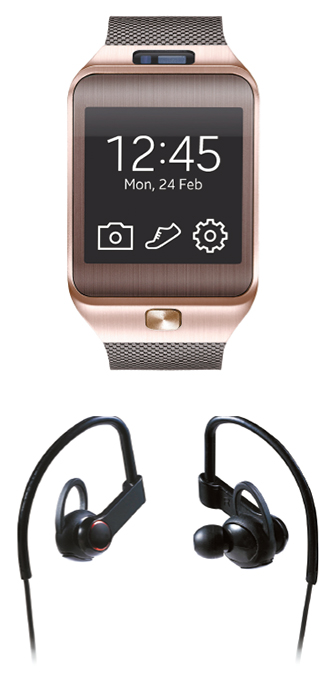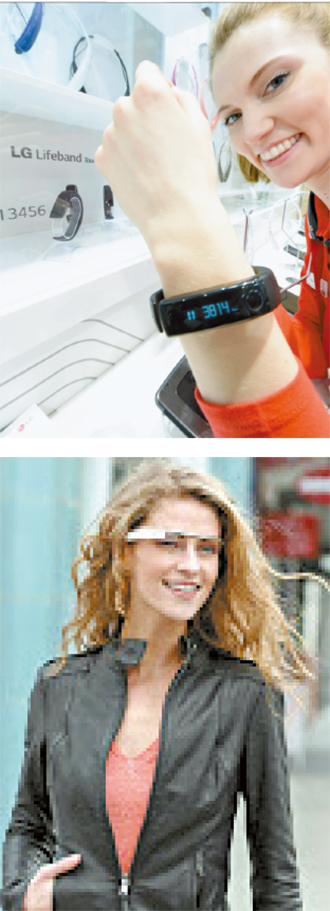Wearables hot, but future unclear

Wearable devices are the hottest new trend in the electronics industry, with many new ones soon to be released. From top: Samsung Electronics’ Gear 2 Neo; LG Electronics’ Heart Rate Earphone
For instance, Misfit, a U.S.-based firm, has released Shine, a coin-sized device that can be worn as a necklace, watch or earring, depending on your mood.
The Cynaps Bone Conduction hat by Max Virtual, which won the top award at the Wearable Technology Expo in New York last year, is a Bluetooth-enabled headset built into a hat that transmits sound, not by earphones but through the bones of your skull.
FlyFit is a new type of fitness tracker that attaches to your ankle and tracks your motion. Lumo Lift, which clips onto the shirt, helps improve posture by sending vibrations to a wearer with bad posture. And one Japanese company, NS West, recently came out with a smartphone ear clip. Hooked up to a smartphone, it can measure the heart rate, act as a GPS and can be turned on and off by facial movements. The possible innovations seem endless.
According to IMS Research, the global wearable device market will grow from around $2 billion in 2011 to $6.7 billion by 2016, which works out to 27 percent annual growth.
With that kind of growth, many market research firms are expanding their monitoring of wearables. The NPD Group said recently that it has started tracking 79 wearable tech products.
In addition, there are several hotly awaited products that, if launched, could spur development even faster. Google Glass is already being used by thousands of beta testers and could be ready for mass consumption soon. Others are eager for Apple’s iWatch.
“Whether the wearable market expands extensively this year depends on whether Apple’s iWatch brings the market innovation that Apple brought with iPhone,” said Sophia Kim, a researcher at Woori Investment and Securities,

LG Electronics’ LifeBand Touch; and Google Glass.
LG Electronics introduced Prada Link, a smartwatch synced to the Prada phone in 2008, five years earlier than Samsung’s Galaxy Gear. And now LG is back with its LifeBand Touch, a fitness tracker. Unveiled initially at the International Consumer Electronics Show in Las Vegas in January, the Touch has a built-in sensor that allows users to turn it on simply by a twist of the wrist. LG reportedly has been working on a comprehensive wearable business strategy, backed by sizable resources.
Even domestic companies not directly making wearable products are also enjoying increasing attention. Hyundai Securities recently picked LG Display, Cheil Industries and AP System, among others, as the companies that could benefit the most from the advent of the wearable industry. Those companies make OLED displays, which are commonly used with wearable products.
OLED is more popular because it is needed for flexible devices, which many companies are trying to use for wearables. Samsung Gear Fit already has the world’s first curved display for fitness trackers. The flexible display market will grow from $100 million this year to $1.3 billion in 2016 and $67.7 billion by 2023, according to market research firm IHS.
The Korean government is also increasing efforts to help Korea stay at the cutting edge of wearable technology. The Wearable Smart Device Forum was launched on Tuesday in Seoul, hosted by the Ministry of Trade, Industry and Energy. Local companies, including Samsung and LG, as well as small and midsized enterprises, participated in it. About 50 experts from business and academia have agreed to gather once a month and to come up with policy advice, according to the ministry.
“Although Korea holds high technology levels in areas that are the basis for the wearable industry, such as electric and electronics, ICT and fabric, we lack capabilities in the development of material and element technologies to apply these technologies,” said an official of the ministry.
Last year, the ministry suggested wearable smart devices as one of 13 growth engines for the creative economy initiative by the Park Geun-hye administration.
But for now, experts say wearable devices need better technology to advance more and find a clearer purpose before they can take off as an industry.
“Why should we buy wearable products? If you can’t suggest the answer to the question, it will be difficult to create a sizable market,” said Seo Ki-man, a researcher at the LG Economic Research Institute.
BY MOON GWANG-LIP [joe@joongang.co.kr]










with the Korea JoongAng Daily
To write comments, please log in to one of the accounts.
Standards Board Policy (0/250자)